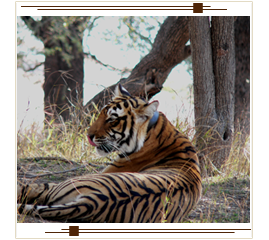It is hailed as one of India's fnest wildlife destinations. Earlier the hunting
reserve of the Maharajas of Jaipur, the park at Ranthambhore was once the scene
of royal hunting parties. Today, it is famous for its tigers and is one of the best
places in the country to see these majestic predators in the wild. The Park covers
an area of nearly 400 sq. km. and is set between the Aravali and Vindhya ranges.
Its deciduous forests were once a part of the magnificent jungles of Central India.
Ranthambore National Park is in Sawai Madhopur District of Rajasthan state.
It was declared a wildlife sanctuary in 1957 and in 1974 it gained the protection
of "Project Tiger". It got its status of a National Park in 1981.
Ranthambore National Park is dotted with structures that remind you of bygone eras.There
are many water bodies located all over the park, which provide perfect relief during
the extremely hot summer months for the forest inhabitants. A huge fort, after which
the park is named, towers over the park atop a hill. There are many ruins of bygone
eras scattered all over the jungle, which give it a unique, wonderful and mixed
flavour of nature, history and wildlife. Tigers at Ranthambore National park have
been known to even hunt in full view of human visitors. These tigers are famous
for being seen in the daytime too, due to their lack of fear of human presence in
vehicles. This lack of fear of humans is excellent for tourists, as they get to
see the tigers often.
This National park is a wildlife enthusiast and photographer's dream. It offers
excellent internal transportation facilities. The park remains open every year from
October to May. Famous for the exciting and frequent tiger sightings captured dramatically
in several books, this park is today affected by ecological pressures and poaching.
It spreads over a highly undulating topography varying from the gentle to the steep slopes; from flat topped hills of the Vindhayas to the conical hillocks and the sharp ridges of the Aravalis. An important geological feature the 'Great Boundary Fault' where the Vindhaya plateaus meet the Aravali hill ranges meanders through the reserve. The National Park is bounded by the rivers Chambal in the South and the Banas in the North. Pure stands of the Dhok interspersed with open grasslands of the plateaus, six large lakes - Gilai Sagar, Mansarovar, Malik talao, Raj Bagh and Padam Talao with in the National Park. Ranthambore National park contains a huge variety of animals, birds and reptiles within it. Primarily the population consists of...
Tigers, Leopards, Striped Hyenas, Sambar deer, Chital, Nilgai, Common or Hanuman langurs, Macaques, Jackals, Jungle cats, Caracals, Sloth bears, Black bucks, Rufoustailed Hare, Indian Wild Boar, Chinkara, Common Palm Civets or Toddy cat, Coomon Yellow Bats, Desert Cats, Fivestriped Palm Squirels, Indian False Vampires, Indian Flying Foxes, Indian Foxes, Indian Gerbilles, Indian Mole Rats, Indian Porcupines, Long eared Hedgehogs, Ratels, Small Indian Mongoose, Small Indian Civets and Common mongoose. The park is most famous for its diurnal tigers. The amphibian species only consist of the Common India Toad and the Common Frog.
Snub Nosed Marsh Crocodiles, Desert Monitor Lizards, Tortoise, Banded Kraits, Cobras, Common Kraits, Ganga Soft Shelled Turtles, Indian Pythons, North Indian Flap Shelled Turtles, Rat Snakes, Russel's Vipers, Saw-scaled Vipers and the Indian Chamaeleon.
The vegetation in the park is mostly of the dry deciduous type with a large variety
consisting of nearly 300 species. The majority of the tree cover is however mainly
made up of:
Am (Magnifera Indica)
Imli (Tamarindicus indica)
Babul (Accasia nilotica)
Banyan (Ficus benghalensis)
Ber (Zizyphus mauritania)
Dhak or Chila (flame of the forest){Butea monosperma}
Dhok (Anogeossispendula)
Jamun (Syzygium cumini)
Kadam (Authocephalus cadamba)
Khajur ( Phoenix sylvestris)
Khair (Accacia catechu)
Karel (Capparis decidua)
Khejda (Prosopis specigera)
Kakera (Flacourtiaindica)
Mohua (Madhuca indica)
Neem (Azadirachta indica)
Dhok forms a majority of the tree cover
Oct 1-Oct 31
Total area: 392.5 sq. kms.
Ranthambhore National Park (core) 274.50 sq. kms.
Buffer area to R.N.P. 118.00 sq. kms.
